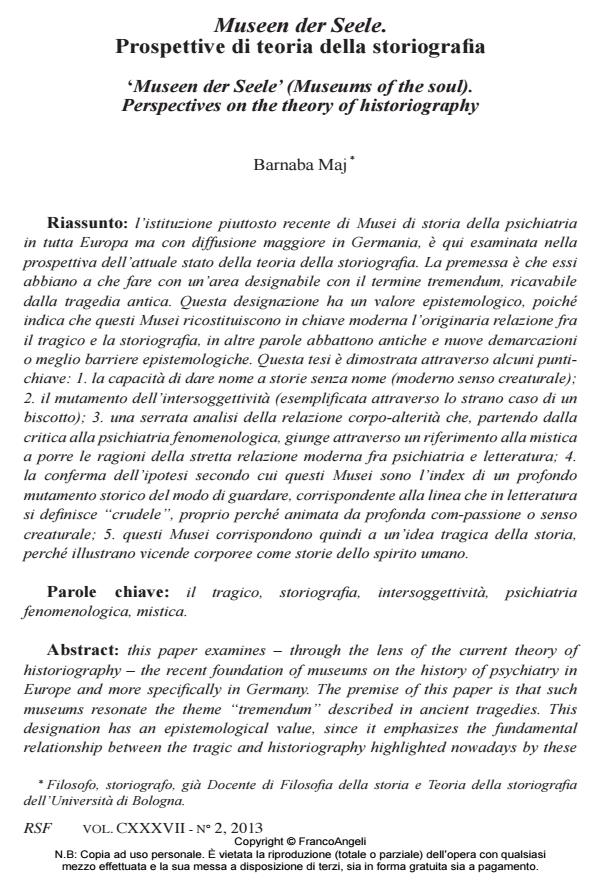Museen der Seele. Prospettive di teoria della storiografia
Journal title RIVISTA SPERIMENTALE DI FRENIATRIA
Author/s Barnaba Maj
Publishing Year 2013 Issue 2013/2
Language Italian Pages 15 P. 15-29 File size 1787 KB
DOI 10.3280/RSF2013-002002
DOI is like a bar code for intellectual property: to have more infomation
click here
Below, you can see the article first page
If you want to buy this article in PDF format, you can do it, following the instructions to buy download credits

FrancoAngeli is member of Publishers International Linking Association, Inc (PILA), a not-for-profit association which run the CrossRef service enabling links to and from online scholarly content.
This paper examines - through the lens of the current theory of historiography - the recent foundation of museums on the history of psychiatry in Europe and more specifically in Germany. The premise of this paper is that such museums resonate the theme "tremendum" described in ancient tragedies. This designation has an epistemological value, since it emphasizes the fundamental relationship between the tragic and historiography highlighted nowadays by these museums. In other words, the museums break down past and present demarcations, or epistemological barriers. This argument is based on five key points: 1) The capacity to give a name to unnamed narratives. 2) The historical evolution of inter-subjectivity. 3) A close analysis of the relationship between body and alterity (otherness), inspired by a critique of phenomenological psychiatry, explains - through a reference to mysticism - the sense of the present-day close relationship between psychiatry and literature. 4) The corroboration of the hypothesis that these museums are the index of a profound historical change in the way of understanding, in literature trend labeled with the expression "cruel", precisely because this approach expresses a deep sense of com-passion or of creatureliness. 5) These museums exhibit therefore a tragic idea of history, as they describe body happenings as narratives of the soul.
Keywords: The Tragic, historiography, inter-subjectivity, phenomenological psychiatry, mysticism.
- Musei della Mente. Luoghi e allestimenti per la valorizzazione del patrimonio manicomiale Francesca Lanz, in RIVISTA SPERIMENTALE DI FRENIATRIA 3/2023 pp.87
DOI: 10.3280/RSF2023-003008
Barnaba Maj, Museen der Seele. Prospettive di teoria della storiografia in "RIVISTA SPERIMENTALE DI FRENIATRIA" 2/2013, pp 15-29, DOI: 10.3280/RSF2013-002002